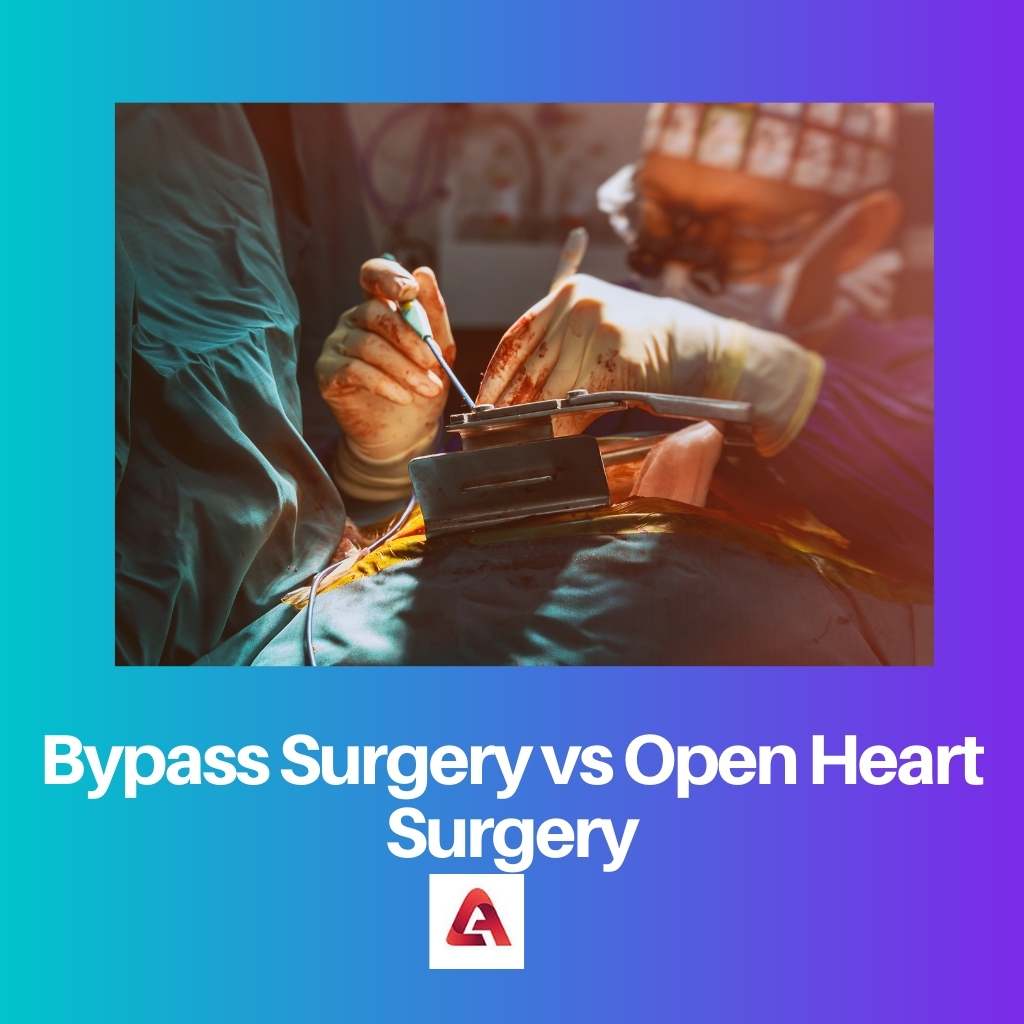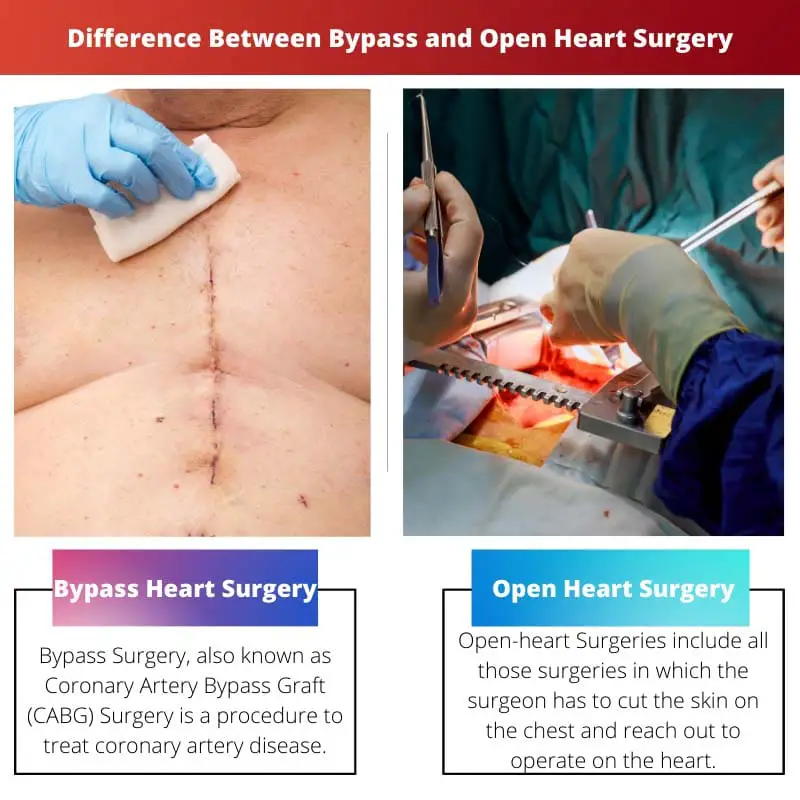Heart-related problems have now become more common than in previous decades. Some of such problems don’t always require surgery, and they can be avoided with a healthy lifestyle.
However, in some extreme symptoms, surgeries are needed to prevent the issue from being life-threatening. Two such heart-related surgeries are known as Bypass Surgery and Open-heart Surgery.
Key Takeaways
- Bypass surgery addresses blocked arteries by creating new pathways for blood flow, while open-heart surgery involves any procedure where the chest is opened to access the heart.
- Bypass surgery is an open-heart surgery, but not all are bypass procedures.
- Open-heart surgeries encompass various procedures, such as valve replacements or heart transplants.
Bypass Surgery vs Open Heart Surgery
Bypass is a procedure in which a new pathway is created to divert blood flow around a blocked or narrowed artery or vein. Used to treat many health-related issues like heart disease. Open-heart surgery involves opening the chest to reach the heart to do surgical procedures on the heart muscle, valves, or arteries.

Bypass Surgery, also known as Coronary Artery Bypass Graft (CABG) Surgery, is a type of surgery in which the surgeon, through a procedure, restores normal blood flow to a blocked coronary artery.
Bypass surgery is a type of open-heart surgery.
Open-heart surgeries include all those surgeries in which the surgeon has to cut the skin on the chest and reach out to operate on the heart.
Depending on the surgery, the surgeon might also have to cut through portions of the heart. Open-heart surgeries are a type of Cardiac Surgery.
Comparison Table
| Parameters of Comparison | Bypass Heart Surgery | Open Heart Surgery |
|---|---|---|
| Types | Single Bypass, Double Bypass, Triple Bypass, and Quadruple Bypass. | Bypass Surgery, Heart Transplant, Maze surgery, etc. |
| Post-Operative Symptoms | Constipation, mood swings, difficulty sleeping, etc. | Aches, numbness in elbows, Swelling of chest cut, etc. |
| Risks | Increased risks of a heart attack, lung problems, fever, pneumonia, etc. | Bleeding, Ischemic Heart Damage, Blood Clots, etc. |
| Recovery Time | Full recovery within 12 weeks. | Most patients recover in 4-6 weeks, but it may vary. |
| Success Rate | 97-98% of bypass surgeries are successful. | About 96% of open-heart surgeries are successful. |
What is Bypass Heart Surgery?
Bypass Surgery, also known as Coronary Artery Bypass Graft (CABG) Surgery is a procedure to treat coronary artery disease. Coronary artery disease (CAD) is the narrowing of the coronary arteries.
These arteries are the blood vessels that supply oxygen to the heart. This disease is caused by a prolonged development of fatty material within the arteries’ walls.
As a result, the arteries’ insides narrow down, limiting the supply of oxygen-rich blood to the heart. Bypass Surgery is one of the most common open-heart surgeries.
To bypass the problematic coronary artery, the surgeon makes an incision in the chest walls and temporarily stops the heart.
Once the heart is reachable, the tubes are inserted into the heart so that a heart-lung bypass machine can pump the blood.
The bypass machine is necessary to pump blood while the heart is stopped.
Even though this traditional open-heart surgery is preferred, less invasive techniques are also available in which the heart doesn’t have to be stopped.
There are four types of bypass surgeries: single bypass, double bypass, triple bypass, and quadruple bypass.
Bypass Surgery is not new; advancements have been made to minimize the risks. Hence, bypass surgeries are safe.
What is Open Heart Surgery?
Open-heart Surgeries include all those surgeries in which the surgeon has to cut the skin on the chest and reach out to operate on the heart.
Open-heart surgeries include procedures done on the heart, valves, arteries, aorta, and large arteries connected to the heart.
Open-heart surgeries are very common, and most of these surgeries are nearly risk-free. These surgeries are a type of Cardiac Surgeries.
Some common open-heart surgeries include bypass surgery, heart Transplant, maze surgery, heart valve surgery, etc.
There are two methods to perform open-heart surgeries:
- On-pump: In this method, a heart-lung bypass machine connects to the heart and temporarily stops it from beating.
- Off-pump: In this method, the surgery is performed while the heart is stabilized but is still beating. However, this method is only applicable to bypass surgeries.
Before any open-heart surgery is performed, the patient is asked to stop taking certain blood-thinning medications a few weeks before, reduce alcohol intake, quit smoking, have healthy food consumption, etc.
Carelessness in these factors can lead to risky complications in the surgery. After the surgery, it is recommended that patients be indulged in minor physical tasks, chest physiotherapy, regular walking, restricted salt consumption, etc.
Main Differences Between Bypass and Open Heart Surgery
- The recovery time of patients after bypass surgery is about 12 weeks, while patients after open-heart surgeries can take longer to heal, depending on the type of surgery.
- Most bypass surgery patients survive more than 10 years at least, whereas not all open-heart surgeries promise such survival rates.
- Bypass surgery procedure is nearly risk-free, whereas open-heart surgeries can cause life-threatening symptoms.
- Bypass surgery can be performed by both on-pump and off-pump methods. On the other hand, open-heart surgeries require an on-pump method only.
- Bypass surgery includes working on the blocked coronary arteries only, whereas open-heart surgeries include surgeries on all parts of the heart.



